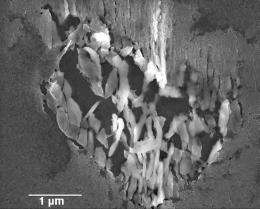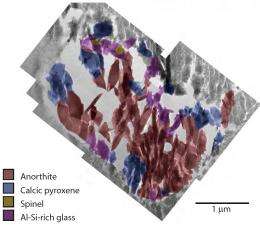First measurement of the age of cometary material

(PhysOrg.com) -- Though comets are thought to be some of the oldest, most primitive bodies in the solar system, new research on comet Wild 2 indicates that inner solar system material was transported to the comet-forming region at least 1.7 million years after the formation of the oldest solar system solids.
The research by Lawrence Livermore National Laboratory scientists and colleagues provides the first constraint on the age of cometary material from a known comet. The findings are published in the Feb. 25 edition of Science Express.
The NASA Stardust mission to comet Wild 2, which launched in 1999, was designed around the premise that comets preserve pristine remnants of materials that helped form the solar system. In 2006, Stardust returned with the first samples from a comet.
Though the mission was expected to provide a unique glimpse into the early solar system by returning a mix of solar system condensates, amorphous grains from the interstellar medium and true stardust (crystalline grains originating in distant stars), the initial results painted a different picture. Instead, the comet materials consisted of high-temperature materials including calcium-aluminum rich inclusions (CAIs), the oldest objects formed in the solar nebula. These objects form in the inner regions of the solar nebula and are common in meteorites.

The presence of CAIs in comet Wild 2 indicates that the formation of the solar system included mixing over radial distances much greater than has been recognized by scientists in the past.
"The inner solar system material in Wild 2 underscores the importance of radial transport of material over large distances in the early solar nebula," said lead author Jennifer Matzel of the Laboratory's Institute of Geophysics and Planetary Science and the Glenn T. Seaborg Institute. "These findings also raise key questions regarding the timescale of the formation of comets and the relationship between Wild 2 and other primitive solar nebula objects."
Analysis showed that the inner solar system materials formed 1.7 million years after the onset of CAI formation.
Provided by Lawrence Livermore National Laboratory



















